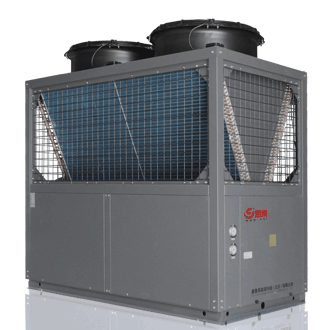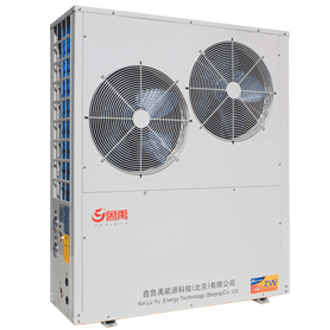推荐产品
欧洲的寒冷气候空气源热泵(低温空气源热泵)初识
Cold Climate Air Source Heat Pump(寒冷气候空气源热泵)(ccASHP) / (低温空气源热泵)
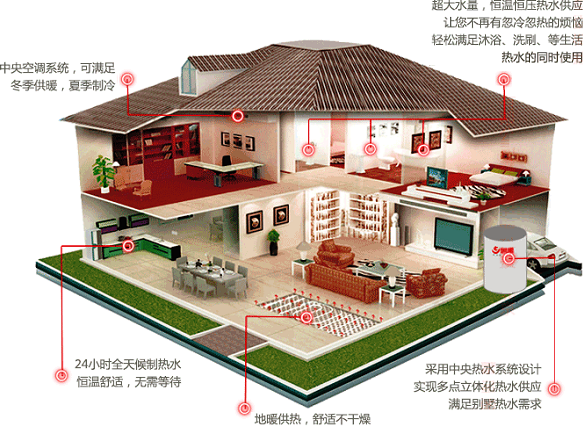
独立住宅使用“空气源热泵系统”(配合其它形式的制热系统混合使用)正在成为欧洲供暖系统的热门选择。
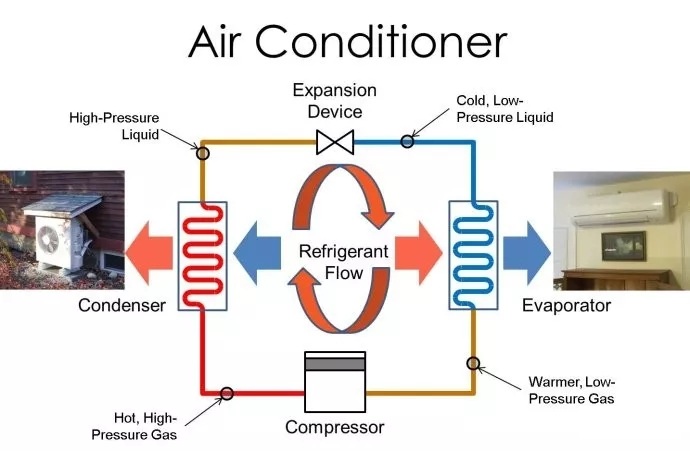
空气源热泵构成原理示意图
Air Conditioner(空气调节器 / 空调)
(左边)Condenser(冷凝器)、(右边)Evaporator(蒸发器)、
(下边)Compressor(压缩机)、(上边)Expansion Device(膨胀装置)
(图中左边)High-Pressure Liquid(高压液体)、Hot, High-Pressure Gas(热,高压气体)
(图中右边)Cold, Low-Pressure Liquid(冷,低压液体)、Warmer, Low-Pressure Gas(温暖,低压气体)
(图中最左边)空气源热泵系统的室外风机;(图中最右边)空气源热泵系统的室内风机。
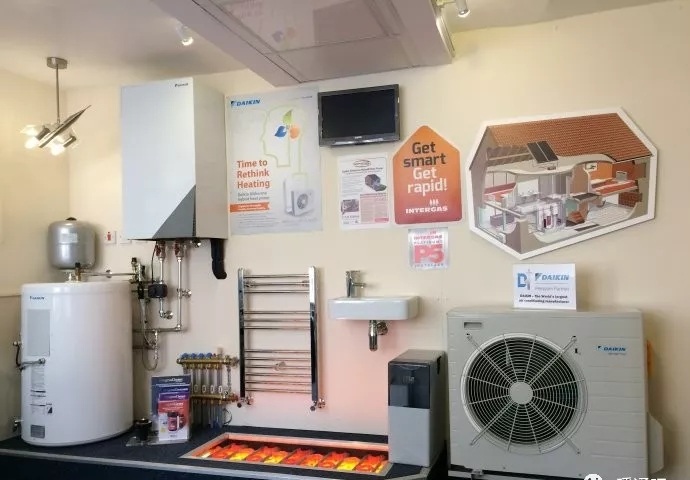
欧洲一采暖设备厂商的实物样品展厅内部一瞥\
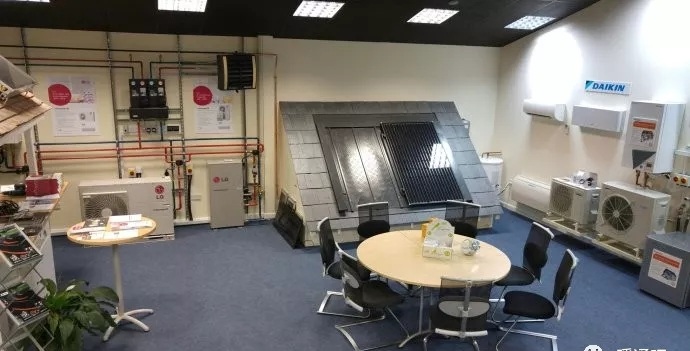
欧洲一采暖设备厂商的实物样品展厅内部一瞥
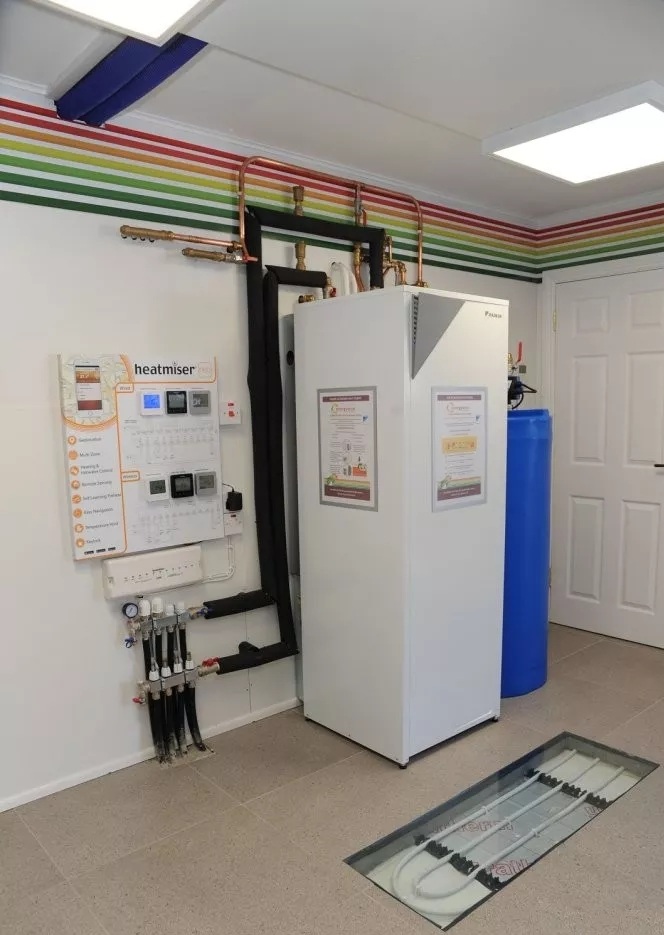
欧洲一采暖设备厂商的实物样品展厅内部一瞥
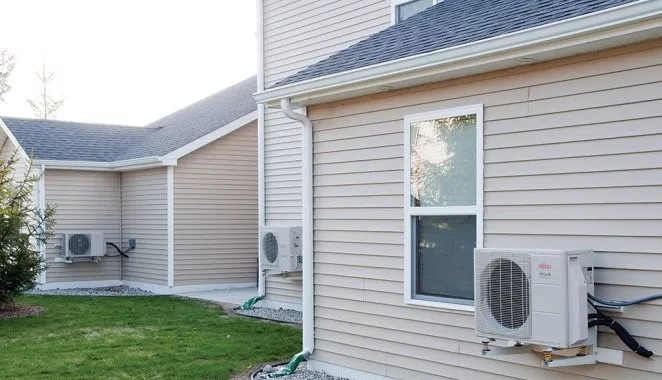
欧美某地一轻型木结构独立住宅的外面,可见安装有“空气源热泵系统”的室外风机。
(跟过去常见的使用电力的空调系统的室外风机相似,但工作原理不一样,节能减碳效果也不一样)。
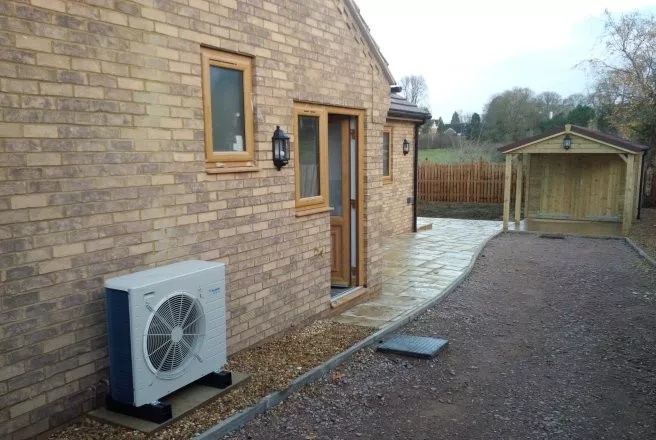
欧洲某地一轻型木结构独立住宅的外面,可见安装有“空气源热泵系统”的室外风机。

欧洲某地一轻型木结构独立住宅的外面,可见安装有“空气源热泵系统”的室外风机。
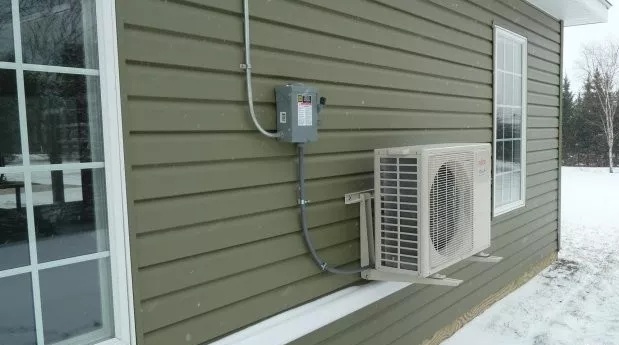
欧洲某地一轻型木结构独立住宅的外面,可见安装有“空气源热泵系统”的室外风机(跟过去常见的使用电力的空调系统的室外风机相似)。
Exploring Climate Solutions Renewable Thermal Technologies: Heat Pumps
(探索气候解决方案可再生热能技术:热泵)
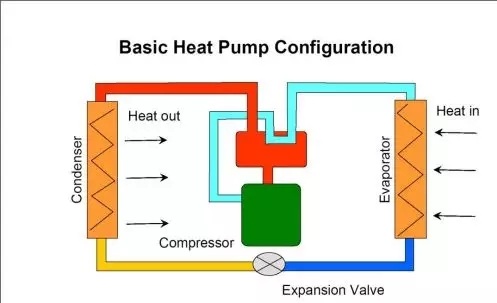
Basic Heat Pump Configuration(基本热泵配置)
Condenser(冷凝器)、Evaporator(蒸发器)、Compressor(压缩机)、Expansion Valve(膨胀阀)
Heat out(放热)、Heat in(吸热)
Types of Renewable Thermal Technologies(可再生热能技术的类型:)
1、Heat Pumps(热泵)
(1)、Air Source Heat Pumps (heating, cooling)(空气源热泵(加热,冷却))
(2)、Heat Pump Water Heaters (water)(热泵热水器(水))
(3)、Ground Source Heat Pumps (heating, cooling, water)(地源热泵(加热,冷却,水))
2、Solar Thermal(太阳能热)
3、Biomass(生物质能)
4、Biodiesel(生物柴油)
What is a heat pump and how does it work?(什么是热泵,它是如何工作的?)
The technology is fundamentally no different than that used in a refrigerator.
(这项技术与冰箱使用的技术基本上没有区别。)
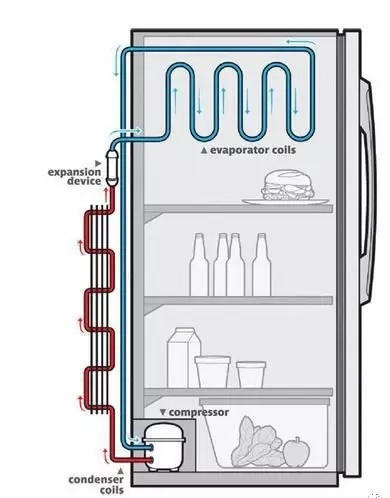
The primary advantage of heat pumps is that it is using electricity to move heat versus converting electricity directly to heat.
(热泵的主要优势在于它利用电力来传递热量,而不是直接将电力转化为热量。)
Thus they can be up to four + times more efficient than electric heat because they take advantage of “free” thermal (heat) energy.
(因此,它们可以比电热效率高出四倍以上,因为它们利用了“自由”热(热)能。)
Heat pumps do not utilize combustion, so no chimney or venting is required.
(热泵不使用燃烧,所以不需要烟囱或排出废气。)
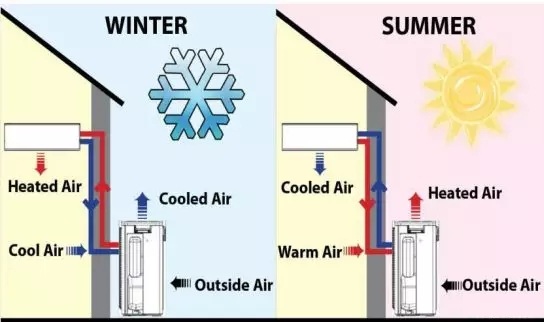
One disadvantage of heat pumps is that their efficiency is a function of outdoor (or ground) temperature.
(热泵的一个缺点是其效率是室外(或地面)温度的函数。)
– Heating capacity and efficiency is lower with lower source temperature.
(——热源温度越低,热效率越低。)
– Cooling capacity and efficiency is lower with higher source temperatures
(——源温度越高,冷却能力和冷却效率越低。)
Ground Source Heat Pumps (aka “Geothermal Heat Pumps”)
(地源热泵(又名“地热热泵”))(该部分的详细内容介绍——略)
Air Source Heat Pumps(空气源热泵)
Use the outdoor air as the heat sink and heat source.(使用室外空气作为散热器和热源。)
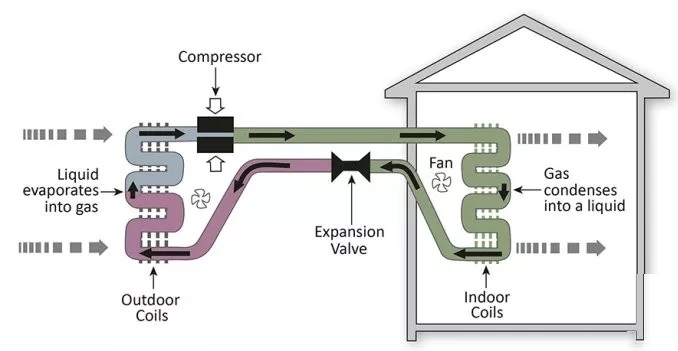
Expansion Valve(膨胀阀)、Outdoor Coils(室外换热器)、Liquid evaporates into gas(液体蒸发成气体)、Compressor(压缩机)、Fan(风扇)、Gas condenses into a liquid(气体凝结成液体)、Indoor Coils(室内换热器)
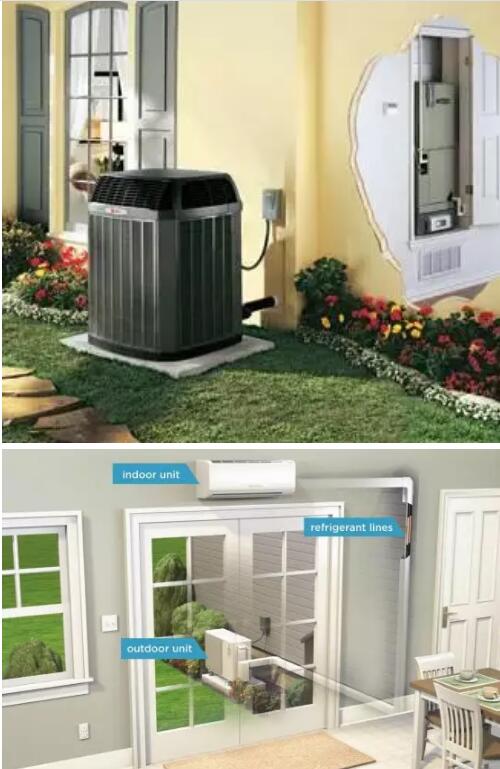
Indoor unit(室内单元部分)、outdoor unit(室外单元部分)、refrigerant lines(制冷剂管路)
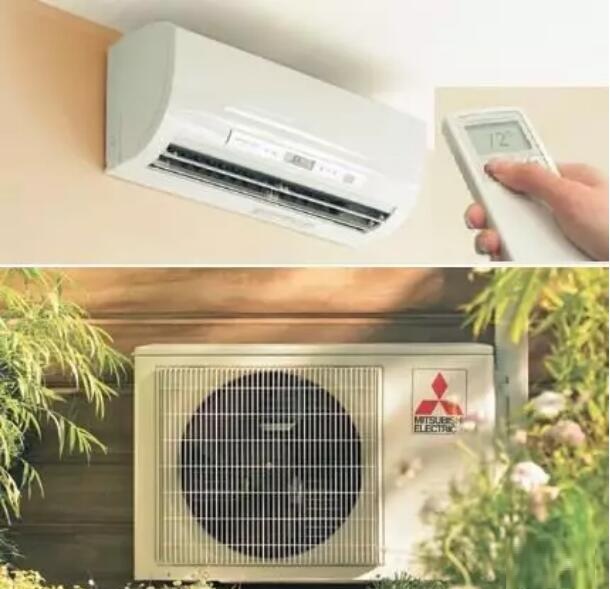
– Ducted heat pumps(——导管式热泵)
– Ductless heat pumps(——无导管热泵)
– Heat Pump Water Heaters(热泵热水器)
Not as efficient as ground source heat pumps and work best in milder climates.
(不如地源热泵效率高,在较温和的气候条件下效果最佳。)
– Heating performance (capacity and efficiency) drops as outdoor air temperature drops.
(——随着室外空气温度下降,加热性能(容量和效率)下降。)
– Cooling performance (capacity and efficiency) drops as outdoor temperature rises.
(随着室外温度升高,制冷性能(容量和效率)下降。)
New generation heat pumps are greatly improved: they will work and can provide value in very cold climates.
(新一代热泵有了很大的改进:它们能工作,并能在非常寒冷的气候条件下提供价值。)
New Generation “Cold Climate” Ductless Heat Pumps
(新一代“寒冷气候”无通道热泵)
Greatly improved performance.(性能大大提高。)
However, supplemental heating may be required for low outdoor temperatures.
(然而,对于室外低温,可能需要补充加热。)
However, most (sometimes all) of load can still be met.
(但是,大部分(有时是全部)负载仍然可以被满足。)
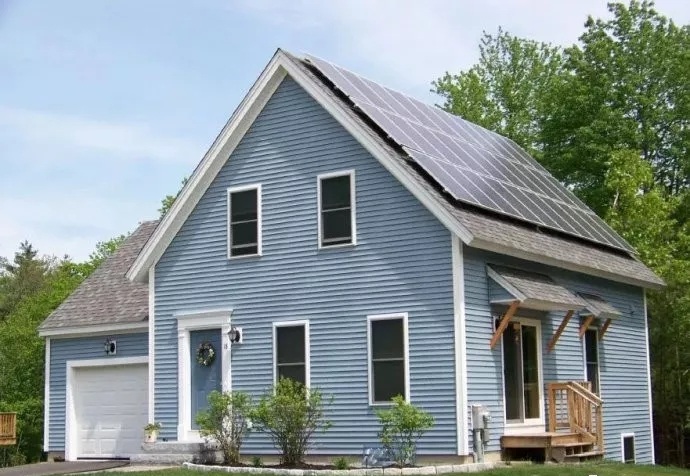
马萨诸塞州零能源之家2个区域使用空气源热泵
Builder:Carter Scott,Transformations Inc.
Customers face a myriad of options!(用户面临着多种选择!)
Cold Climate Heat Pumps Using Tandem Compressors
(采用串联式压缩机的寒冷气候热泵)
In cold climate zones, e.g. ASHRAE climate regions IV and V, conventional electric air-source heat pumps (ASHP) do not work well, due to high compressor discharge temperatures, large pressure ratios and inadequate heating capacities at low ambient temperatures.
(在寒冷地区,例如,美国采暖、制冷与空调工程师学会ASHRAE(American Society of Heating, Refrigerating and Air-Conditioning Engineers)气候区域IV和V,传统的电动空气源热泵(ASHP)由于压缩机排放温度高,压力比大,在低温环境下制热能力不足,效果不佳。)
Consequently, significant use of auxiliary strip heating is required to meet the building heating load.
(因此,需要使用辅助加热装置来满足建筑物的供暖负荷。)
We introduce innovative ASHP technologies as part of continuing efforts to eliminate auxiliary strip heat use and maximize heating COP with acceptable cost-effectiveness and reliability.
(我们努力引入创新的具有可接受的成本效益和可靠性的空气源热泵技术作为其中的一部分,消除辅助热利用,最大限度地提高供热效率。)
These innovative ASHP were developed using tandem compressors, which are capable of augmenting heating capacity at low temperatures and maintain superior part-load operation efficiency at moderate temperatures.
(这些创新的空气源热泵采用串联式压缩机开发,在较低的温度下,可增加供热能力,保持良好的部分负荷运行效率在温和的温度。)
Two options of tandem compressors were studied; the first employs two identical, single-speed compressors, and the second employs two identical, vapor-injection compressors.
(研究了串联式压缩机的两种选择:第一种采用两种相同的单速压缩机,第二种采用两种相同的蒸汽喷射压缩机。)
The investigations were based on system modeling and laboratory evaluation.
(调查以系统建模和实验室评价为基础。)
Both designs have successfully met the performance criteria.
(这两种设计都成功地达到了性能标准。)
Laboratory evaluation showed that the tandem, single-speed compressor ASHP system is able to achieve heating COP = 4.2 at 47 F (8.3 C), COP = 2.9 at 17 F (-8.3 C), and 76% rated capacity and COP = 1.9 at -13 F (-25 C).
(实验室评估显示,串联,单速压缩机热泵系统能够在47 F实现供热系数= 4.2(8.3℃),COP = 2.9 17 F(8.3 C),和76%的额定容量和COP = 1.9 - 13 F(25 C)。)
This yields a HSPF = 11.0 (per AHRI 210/240).
(这就产生了HSPF = 11(每AHRI 210 / 240)。)
Cold-climate air source heat pumps (ccASHPs) are a high-efficiency technology that is an ideal candidate for homes relying on delivered fuels or electricity for space heating.
(寒冷气候空气源热泵(ccASHPs)是一种高效率的技术,是依靠交付燃料或电力进行供暖的家庭的理想选择。)
These designs have improved the capacity and effectiveness of ASHPs for a greater portion of the cold-climate heating season, thus reducing electricity use and limiting the need for backup heating.
(这些设计提高了ASHP在寒冷气候供暖季节的大部分时间的能力和有效性,从而减少了电力的使用,并限制了对后备供暖的需求。)
Space heating energy savings of 39% to 65% and cost savings of 14%-29% were found.
(发现空间加热节能39%至65%,节约成本14%-29%。)
Air source heat pumps (ASHPs) use a compression cycle refrigeration system to transfer heat from one location to another, allowing the system to heat a home during the winter and cool it during the summer.
(空气源热泵(ASHP)使用压缩循环制冷系统将热量从一个地方传输到另一个地方,从而使系统在冬季为家庭供暖,并在夏季降温。)
ASHP systems consist of an outdoor unit that contains a fan, outdoor coil, compressor, and expansion valve, and an indoor unit that contains an indoor coil and a fan.
(空气源热泵系统包括一个室外单元,包含一个风机,室外盘管,压缩机和膨胀阀,以及一个包含室内盘管和风扇的室内机。
In heating mode the outdoor unit uses a fan to draw outside air across a heat exchanger and absorb heat from the outdoor air.
(在制热模式下,室外机使用风扇将外界空气吸入热交换器,吸收室外空气中的热量。)
The compressor warms the refrigerant further by increasing the pressure of the refrigerant in the system.
(压缩机通过增加制冷剂在系统中的压力进一步加热制冷剂。)
The warm refrigerant runs through the heat exchanger in the indoor unit, where cooler air from the house absorbs the heat from the refrigerant before the indoor fan delivers the heated air throughout the house.
(温暖的制冷剂流经室内机的热交换器,在室内风机将热空气传送到整个房屋之前,室内较冷的空气吸收制冷剂的热量。)
In cooling mode, the system runs in the opposite direction removing heat from the indoor air and transferring it outside, like a traditional air conditioning system.
(在制冷模式下,系统运行方向相反,将室内空气中的热量传递到外部,就像传统的空调系统一样。)
ASHPs transfer heat from one location to another and do not generate heat directly.
(空气源热泵将热量从一个地方转移到另一个地方,不直接产生热量。)
This heat transfer process makes ASHPs a highly efficient form of space heating and cooling, outputting more heat energy than the electrical energy required to run the system.
(这种传热过程使空气源热泵ASHP成为空间加热和冷却的高效形式,输出比运行系统所需的电能更多的热能。)
ASHP systems are widely used for space heating in climates with mild heating seasons, and with recent upgrades, can now meet the majority of a home’s heat load in colder climates.
(空气源热泵系统广泛应用于气候温和的加热季节,随着近期的升级,现在可以满足大部分家庭在寒冷气候下的热负荷。)
These systems have the greatest potential for adoption in cold-climate regions where natural gas is not available for space heating.
(这些系统在天然气无法供暖的寒冷气候地区具有最大的应用潜力。)
ASHPs can offset the use of more expensive delivered fuels, and for homes with electric resistance heat, can result in a significant reduction in electrical use.
(空气源热泵可以抵消更昂贵的交付燃料的使用,并且对于具有电阻热的家庭可以导致电力使用的显着减少。)
Additionally, as more federal and state policies require electric generation to become less carbon intensive, ASHPs will increasingly benefit carbon emissions reduction.
(此外,随着越来越多的联邦和国家政策要求发电成为低碳密集型,空气源热泵ASHPs将更加有利于减少碳排放。)
ASHP technology has improved by the addition of an inverter driven compressor and updates to the refrigerant, making the systems better suited for cold-climate heating.
(空气源热泵技术已经由逆变器驱动的压缩机的制冷剂添加和更新改进,使系统更适合寒冷气候加热。)
The inverter driven compressor allows the compressor speed to modulate and increase capacity during periods of colder outdoor air temperatures.
(逆变器驱动压缩机允许压缩机速度调节和增加在寒冷的室外空气温度期间的容量。)
Manufacturers claim that these new, cold-climate systems are able to transfer heat into homes at outdoor air temperatures at and below 0°F.
(制造商声称这些新的、寒冷的气候系统能够在室外空气温度低于华氏0度时将热量传递到家中。)
The Northeast Energy Efficiency Partnerships (NEEP) has created a set of specifications to identify cold climate ASHP (cASH Plus).
(东北能源效率伙伴关系(NEEP)制定了一套确定冷气候空气源热泵(cASH Plus)的规范。)
These specifications include: variable capacity compressor, coefficient of performance (COP) at 5°F ≥ 1.75 at maximum capacity, a heat system performance factor (HSPF) ≥ 10 for ducted systems and ductless single-zone systems, and a HSPF≥ 9 for ductless multi-zone systems (NEEP, 2014).
(这些规格包括:可变容量压缩机,5°F时的性能系数(COP)≥1.75,最大容量时的热性能系数(HSPF)≥10,管道系统和无管单区系统的热性能系数(HSPF)≥10, 无管道多区域系统(NEEP,2014)。)
Figure 1 shows the heating capacity and COP values provided by Trane for the XV20i model of ccASHP which has a reported HSPF = 10 (NEEP, 2014).
(图1显示了由Trane提供的具有报道的HSPF = 10(NEEP,2014)的XVASHi型号的ccASHP的加热容量和COP值。)、
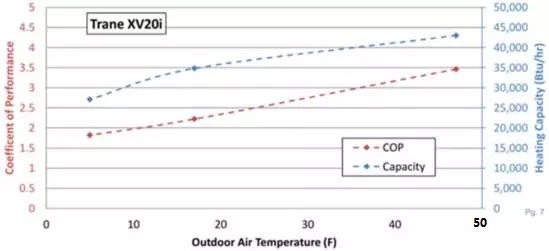
Figure 1. Trane XV20i COP and Heat Capacity. Created from data provided by the manufacturer.
(图1.特灵XV20i COP和热容量。 根据制造商提供的数据创建。)
The high efficiency of ccASHPs can help reduce reliance on delivered fuels for space heating in cold winter states such as Minnesota.
(寒冷气候空气源热泵(ccASHPs)的高效率可以帮助减少在寒冷的冬季州(如明尼苏达州)对供暖燃料的依赖。)
During periods of very cold temperatures when ccASHPS do not have adequate capacity to meet heating load, a furnace or electric resistant heat can be used as backup.
(在非常寒冷的时候,当寒冷气候空气源热泵(ccASHPs)没有足够的容量来满足热负荷时,可以使用炉子或电阻热作为备用。)
As electric generation becomes less carbon intensive, the emissions associated with ASHP’s will decrease, while emissions from propane and heating oil will not.
(随着发电量减少,碳排放量减少,而丙烷和取暖油排放量则减少。)
Annual emissions would be even less with a more efficient ccASHP.
(如果采用更高效的寒冷气候空气源热泵(ccASHPs),年排放量将会更少。)


